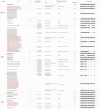Genetic diversity and molecular epidemiology of Middle East Respiratory Syndrome Coronavirus in dromedaries in Ethiopia, 2017-2020
- PMID: 36620913
- PMCID: PMC9888459
- DOI: 10.1080/22221751.2022.2164218
Genetic diversity and molecular epidemiology of Middle East Respiratory Syndrome Coronavirus in dromedaries in Ethiopia, 2017-2020
Abstract
Middle East respiratory syndrome coronavirus (MERS-CoV) is enzootic in dromedary camels and causes zoonotic infection and disease in humans. Although over 80% of the global population of infected dromedary camels are found in Africa, zoonotic disease had only been reported in the Arabia Peninsula and travel-associated disease has been reported elsewhere. In this study, genetic diversity and molecular epidemiology of MERS-CoV in dromedary camels in Ethiopia were investigated during 2017-2020. Of 1766 nasal swab samples collected, 61 (3.5%) were detected positive for MERS-CoV RNA. Of 484 turbinate swab samples collected, 10 (2.1%) were detected positive for MERS-CoV RNA. Twenty-five whole genome sequences were obtained from these MERS-CoV positive samples. Phylogenetically, these Ethiopian camel-originated MERS-CoV belonged to clade C2, clustering with other East African camel strains. Virus sequences from camel herds clustered geographically while in an abattoir, two distinct phylogenetic clusters of MERS-CoVs were observed in two sequential sampling collections, which indicates the greater genetic diversity of MERS-CoV in abattoirs. In contrast to clade A and B viruses from the Arabian Peninsula, clade C camel-originated MERS-CoV from Ethiopia had various nucleotide insertions and deletions in non-structural gene nsp3, accessory genes ORF3 and ORF5 and structural gene N. This study demonstrates the genetic instability of MERS-CoV in dromedaries in East Africa, which indicates that the virus is still actively adapting to its camel host. The impact of the observed nucleotide insertions and deletions on virus evolution, viral fitness, and zoonotic potential deserves further study.
Keywords: Ethiopia; MERS-CoV; evolution; genetic instability; molecular epidemiology.
Conflict of interest statement
No potential conflict of interest was reported by the author(s).
Figures



Similar articles
-
Limited Genetic Diversity Detected in Middle East Respiratory Syndrome-Related Coronavirus Variants Circulating in Dromedary Camels in Jordan.Viruses. 2021 Mar 31;13(4):592. doi: 10.3390/v13040592. Viruses. 2021. PMID: 33807288 Free PMC article.
-
Enzootic patterns of Middle East respiratory syndrome coronavirus in imported African and local Arabian dromedary camels: a prospective genomic study.Lancet Planet Health. 2019 Dec;3(12):e521-e528. doi: 10.1016/S2542-5196(19)30243-8. Epub 2019 Dec 16. Lancet Planet Health. 2019. PMID: 31843456 Free PMC article.
-
Cross-sectional study of MERS-CoV-specific RNA and antibodies in animals that have had contact with MERS patients in Saudi Arabia.J Infect Public Health. 2018 May-Jun;11(3):331-338. doi: 10.1016/j.jiph.2017.09.022. Epub 2017 Oct 6. J Infect Public Health. 2018. PMID: 28993171 Free PMC article.
-
Middle East respiratory syndrome coronavirus (MERS-CoV): animal to human interaction.Pathog Glob Health. 2015;109(8):354-62. doi: 10.1080/20477724.2015.1122852. Pathog Glob Health. 2015. PMID: 26924345 Free PMC article. Review.
-
[Dromedary camels and Middle East respiratory syndrome: MERS coronavirus in the 'ship of the desert'].Ned Tijdschr Geneeskd. 2014;158:A7806. Ned Tijdschr Geneeskd. 2014. PMID: 25248734 Review. Dutch.
Cited by
-
Improving risk analysis of the environmental drivers of the spillover, emergence/re-emergence and spread of Crimean-Congo haemorrhagic fever virus, Marburg virus and Middle East respiratory syndrome coronavirus in the East Africa Region.BMJ Glob Health. 2025 Apr 16;10(4):e019162. doi: 10.1136/bmjgh-2025-019162. BMJ Glob Health. 2025. PMID: 40240055 Free PMC article. Review.
-
Biphasic MERS-CoV Incidence in Nomadic Dromedaries with Putative Transmission to Humans, Kenya, 2022-2023.Emerg Infect Dis. 2024 Mar;30(3):581-585. doi: 10.3201/eid3003.231488. Emerg Infect Dis. 2024. PMID: 38407189 Free PMC article.
-
Genomic Diversity and Recombination Analysis of the Spike Protein Gene from Selected Human Coronaviruses.Biology (Basel). 2024 Apr 22;13(4):282. doi: 10.3390/biology13040282. Biology (Basel). 2024. PMID: 38666894 Free PMC article.
-
The Threat of Impending Pandemics: A Proactive Approach.Cureus. 2023 Mar 27;15(3):e36723. doi: 10.7759/cureus.36723. eCollection 2023 Mar. Cureus. 2023. PMID: 37123718 Free PMC article. Review.
References
-
- Zaki AM, van Boheemen S, Bestebroer TM, et al. . Isolation of a novel coronavirus from a man with pneumonia in Saudi Arabia. N Engl J Med. 2012 Nov 8;367(19):1814–1820. - PubMed
-
- WHO . MERS Situation Update| June 2022; 2022.
-
- Azhar EI, El-Kafrawy SA, Farraj SA, et al. . Evidence for camel-to-human transmission of MERS coronavirus. N Engl J Med. 2014 Jun 26;370(26):2499–2505. - PubMed
-
- https://www.fao.org/statistics/eni [Internet]; 2020.
MeSH terms
Substances
Grants and funding
LinkOut - more resources
Full Text Sources
Other Literature Sources
Miscellaneous
